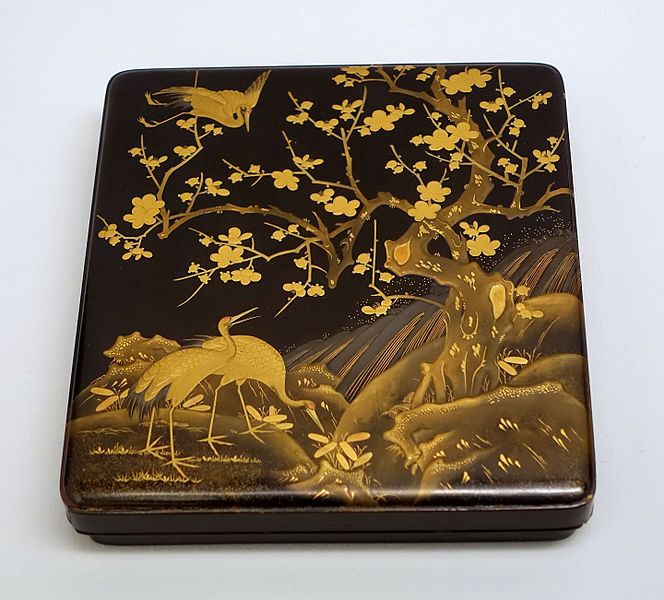Answer: A loan-word from Japanese ? ?urushi?, and then some.
 Writing box with cranes, Japan, Edo period, 1603?1868 AD, wood, black lacquer, gold and silver maki-e ? Linden-Museum ? Stuttgart, Germany (Wikipedia)
Writing box with cranes, Japan, Edo period, 1603?1868 AD, wood, black lacquer, gold and silver maki-e ? Linden-Museum ? Stuttgart, Germany (Wikipedia)
Lacquered objects from Asia are highly treasured works of art. Lacquering was a complicated and sensitive process where the sap of the urushi tree was used to repeatedly coat the object, yielding a smooth and shiny finish. The sap from the urushi tree, or the Asian lacquer tree (Toxicodendron vernicifluum) is rich in a particular mixture of organic compounds that share a common basic structure ? catechol ? with additional atoms in multiple combinations; collectively they are referred to as urushiol (pronounced you-rue-she-ol). The higher the concentration of urushiol in the sap, the smoother and shinier the finish of the lacquer.
 Catechol (black); with additional atoms (R)
Catechol (black); with additional atoms (R)
The urushi tree is a member of the Anacardiaceae family, commonly known as the cashew family; other members of the family include mango, pistachio, and poison ivy. Sumac (Rhus coriaria), a spice that is common in Middle Eastern cuisine, also belongs to the Anacardiaceae family, but lacks urushiol; poison sumac (Toxicodendron vernix) on the other hand does contain urushiol. The two sumacs belong to unique genera in the same family [a botanical family is the equivalent of a town; the genus (plural=genera) is the equivalent of a street; the species is the equivalent of your apartment number].
Urushiol is present at varying concentrations in poison ivy, mango, cashew, and pistachio. It is stored in the vascular system of these plants, and is released when the plant is either touched (poison ivy); or injured (mango, cashew, pistachio, poison ivy). It is hydrophobic (not soluble in water), and can be destroyed at high temperatures. According to the American Academy of Dermatology, ?Most people (85 percent) develop a rash when they get urushiol on their skin.? However, the severity of the rash is a function of how one?s immune system reacts to the urushiol, and also the concentration of urushiol. Because of the high concentration of urushiol in poison ivy, urushiol-sensitive individuals might not react as adversely to exposure to mangoes, as they might to exposure to poison ivy. A video from the National Institute of Occupational Safety and Health (NIOSH) illustrates how urushiol causes an allergic reaction.
The immune response upon exposure to poison ivy ? video from NIOSH
In the case of cashews and pistachios, urushiol is found in the shells; in mangoes it is found in the skin as well as where the stalk meets the fruit, which is where you sometimes find shiny, sticky urushiol beads. Cashews and pistachios are typically sold either roasted or steamed (store-bought ?raw? cashews are really steamed cashews) to destroy urushiol. However, in the case of individuals who have hyper-vigilant immune systems, even these heat-treated nuts can result in allergic reactions. Mangoes are best washed in slightly warm water with a brush to remove residual urushiol beads, and then carefully peeled before eating. As with nuts, people with hyper-vigilant immune systems might have an allergic reaction even to carefully handled mangoes.
Humans appear to be uniquely sensitive to poison ivy ? goats, deer, birds, all eat different parts of the plant but are unaffected by its urushiol. While over-the-counter and prescription products are available to treat reactions to urushiol rashes, there have been several efforts to control poison ivy itself, most notably perhaps by using the fungus Colletotrichum fioriniae in a measured manner. This fungus would be a more desirable option to control poison ivy, since it does not involve the use of chemical herbicides, and has the additional advantage of being an insecticide for a bug that kills hemlock plants. Research on the feasibility of this option is ongoing in John G. Jelesko?s laboratory at Virginia Tech, as the fungus has unfortunately also been shown to adversely affect apples and strawberries.
Summer is a peak time for trips to the emergency room visits from poison ivy exposure; summer is also a peak time for consuming mangoes ? so it seems like a perfect time to get a peek into how the body deals with some allergens (substances that cause allergies). With crushing budgetary cuts to NIOSH (up to 40%), coupled with uncertainty surrounding healthcare under belligerent leadership in Congress, it?s probably a good idea to be well informed about potential health hazards so as not to be overwhelmed by them.
 Poison ivy, mango, cashews, pistachios ? all unified by a Japanese loan-word for a shared chemical ? urushiol
Poison ivy, mango, cashews, pistachios ? all unified by a Japanese loan-word for a shared chemical ? urushiol


